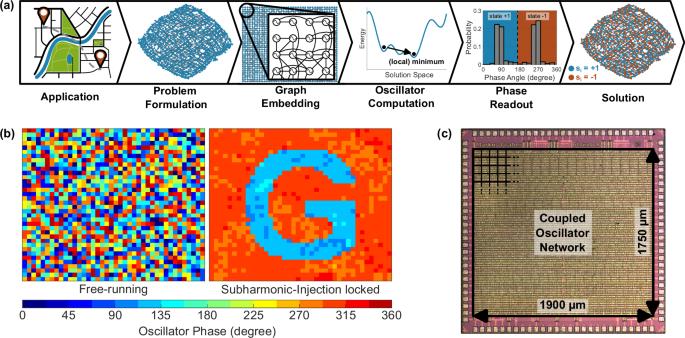An integrated coupled oscillator network to solve optimization problems
引用次数: 0
Abstract
Solving combinatorial optimization problems is essential in scientific, technological, and engineering applications, but can be very time and energy-consuming using classical algorithms executed on digital processors. Oscillator-based Ising machines offer a promising alternative by exploiting the analog coupling between electrical oscillators to solve such optimization problems more efficiently. Here we present the design and the capabilities of our scalable approach to solve Ising and quadratic unconstrained binary optimization problems. This approach includes routable oscillator connections to simplify the time-consuming embedding of the problem into the oscillator network. Our manufactured silicon chip, featuring 1440 oscillators implemented in a 28 nm technology, demonstrates the ability to solve optimization problems in 950 ns while consuming typically 319 μW per node. A frequency, phase, and delay calibration ensures robustness against manufacturing variations. The system is evaluated with multiple sets of benchmark problems to analyze the sensitivity for parameters such as the coupling strength or frequency. Markus Graber and Klaus Hofmann present a coupled oscillator network, fabricated on a 4.6 mm2 silicon chip with 1440 oscillators and routable connections, designed to solve Ising and other optimization problems efficiently. Their circuit offers a scalable and practical approach for complex optimization problems.

解决优化问题的集成耦合振荡器网络
解决组合优化问题在科学、技术和工程应用中至关重要,但使用在数字处理器上执行的经典算法非常耗时耗力。基于振荡器的伊辛机利用电子振荡器之间的模拟耦合来更高效地解决此类优化问题,提供了一种很有前途的替代方案。在此,我们介绍了我们解决伊辛和二次无约束二元优化问题的可扩展方法的设计和功能。这种方法包括可路由振荡器连接,以简化将问题嵌入振荡器网络的耗时过程。我们制造的硅芯片采用 28 纳米技术实现了 1440 个振荡器,能够在 950 ns 内解决优化问题,而每个节点的功耗通常为 319 μW。频率、相位和延迟校准确保了对制造变化的稳健性。该系统通过多组基准问题进行评估,以分析耦合强度或频率等参数的敏感性。Markus Graber 和 Klaus Hofmann 介绍了一种耦合振荡器网络,该网络在 4.6 平方毫米的硅芯片上制造,具有 1440 个振荡器和可路由连接,旨在高效解决伊辛问题和其他优化问题。他们的电路为复杂的优化问题提供了一种可扩展的实用方法。
本文章由计算机程序翻译,如有差异,请以英文原文为准。
求助全文
约1分钟内获得全文
求助全文

 求助内容:
求助内容: 应助结果提醒方式:
应助结果提醒方式:


